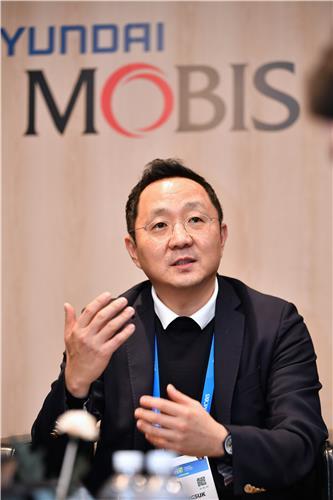Hyundai Mobis Co., South Korea's biggest auto parts maker, will secure 9 trillion won ($7.8 billion) in the next three years for investment in future vehicle technologies, a company executive has said.
In a group interview with South Korean reporters on the sidelines of the Consumer Electronics Show in Las Vegas last week, Hyundai Mobis Vice President Ko Young-suk briefed on how the company will secure the capital and where it will be spent, according to a company spokesperson.
"The company held 7.4 trillion won in cash early last year and it will add 1.4 trillion to 2 trillion won a year to its cash reserves in the following three years, bringing the total to 12 trillion won in 2022. Of that, 3.5 trillion won will remain (as operating capital)," he was cited as saying by the company.
 |
(Yonhap) |
Ko said the company plans to spend 3 trillion won to 5 trillion won on expanding its electrified auto parts production capacity, 4 trillion won to 5 trillion won on the development of core technologies and products and ver 150 billion won on startups.
The company's 2022 capital plan is in line with its board's decision early last year that the parts maker will spend over 4 trillion won through 2021 for capacity expansion, partnerships with domestic and overseas startups and mergers and acquisitions, the spokesperson said.
While increasing its investment in future vehicle technologies, Hyundai Mobis will make further efforts to achieve sales of 44 trillion won by 2025, said Ko, who is in charge of the company's strategic planning division.
"We are aiming to raise the ratio of sales we earn from non-Hyundai Motor Group clients to 40 percent by 2025 from the current 10 percent," he said.
Hyundai Mobis is widely expected to report about 36 trillion won in sales for the year of 2019, higher than the 35 trillion won it made in 2018. It is set to release its 2019 earnings results on Jan. 30.
Hyundai Mobis recently promoted its fully autonomous M.Vision S concept and a hydrogen fuel cell electric system for hydrogen-powered vehicles at the world's biggest consumer technology-focused conference.
The firm introduced Level 4 self-driving technology in its concept M.VISION at the previous CES.
There are five levels of driving automation defined by the Society of Automotive Engineers International.
At Level 4, a vehicle can drive itself under limited conditions and will not operate if all required conditions are not satisfied.
At Level 5, a vehicle's automated driving features can drive under any conditions.
Hyundai Mobis has been conducting motorway tests of Level 3 technology in its M.BILLY autonomous car since 2018 in South Korea, the United States and Europe. Since Level 3 cars are only good for limited self-driving, the driver must be available to take control of the car if the need arises.
A Level 3 car, if fully developed, will allow lane changes and other autonomous driving functions to work without intervention by the driver.
Hyundai Mobis has developed Level 2 technology in which the driver can initiate a lane change on a highway, as well as exit and join highways, if the driver merely uses the indicator light.
Level1 is intended to keep a vehicle in its lane and effectively help protect the driver from the often serious consequences resulting from lack of attention, distraction or a few seconds of micro-sleep.
Looking ahead, Ko said he expected Level 2 cars will account for 85 percent of the autonomous vehicle markets in 2030, with Level 3 and Level 4 cars taking up 10 percent and 5 percent, respectively.
"Most Level 4 cars will be robo-taxis," he said. (Yonhap)





![[Herald Interview] 'Trump will use tariffs as first line of defense for American manufacturing'](http://res.heraldm.com/phpwas/restmb_idxmake.php?idx=644&simg=/content/image/2024/11/26/20241126050017_0.jpg)

![[Health and care] Getting cancer young: Why cancer isn’t just an older person’s battle](http://res.heraldm.com/phpwas/restmb_idxmake.php?idx=644&simg=/content/image/2024/11/26/20241126050043_0.jpg)
